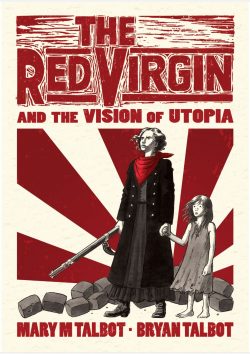

By Mary M Talbot & Bryan Talbot (Jonathan Cape/Dark Horse)
ISBN: 978-0-22410-234-6 (HB Cape) eISBN: 978-1-63008-697-8 (DH)
The power of comics to resurrect historical figures and tap into their lives whilst potently and convincingly extrapolating their deeds and even characters has been a recent revelation that has completely revitalised graphic narratives. One of the most telling and compelling of these narratives was crafted by British National Treasure Bryan Talbot and his even more impressive wife.
Academic, educator, linguist, social theoretician, author and specialist in Critical Discourse Analysis, in 2012 Dr. Mary M. Talbot added graphic novelist to her achievements: collaborating with her husband on the first of many terrific comics tales. Award-winning memoir/biography of Lucia Joyce Dotter of Her Father’s Eyes was followed by Sally Heathcote: Suffragette (drawn by Kate Charlesworth), today’s recommendation, Rain and Armed With Madness: supplementing an educational career and academic publications such as Language and Gender: an Introduction and Fictions at Work: language and social practise in fiction. Dr. Talbot is particularly drawn to true stories of gender bias and social injustice…
Bryan has been a fixture of the British comics scene since the late 1960s, moving from Tolkien-fandom to college strips, self-published underground classics like Brainstorm Comix (starring Chester P. Hackenbush – the Psychedelic Alchemist!), prototypical Luther Arkwright and Frank Fazakerly, Space Ace of the Future to paid pro status with Nemesis The Warlock, Judge Dredd, Sláine, Ro-Busters and more in 2000 AD. Inevitably headhunted by America, he worked on key mature-reading titles for DC Comics (Hellblazer, Shade the Changing Man, The Nazz, Batman: Legends of the Dark Knight, Fables, The Dead Boy Detectives and The Sandman) and was a key creative cog in short-lived shared-world project Tekno Comix, before settling into global acclaim via steady relationships with Dark Horse Comics and Jonathan Cape. These unions generated breakthrough masterpieces like The Tale of One Bad Rat and a remastered Adventures of Luther Arkwright.
Since then he’s been an independent Force To Be Reckoned With, doing just what he wants, promoting the art form in general and crafting a variety of fascinating and compelling works, from Alice in Sunderland o Cherubs! (with Mark Stafford), to Metronome (as Véronique Tanaka) and his fabulously wry, beguiling and gallic-ly anthropomorphic Grandville sequence, as well as his mostly biographical/historical collaborations with Dr. Mary…
In the interest of propriety, I must disclose that I’ve known him since the 1980s, but other than that shameful lack of taste and judgement on his part, have no vested interest in confidently stating that he’s probably Britain’s greatest living graphic novelist…
Here their vast talents combine to capture and expose the life of a woman who arguably reshaped the history of the whole world, but one largely lost to history…
On May 29th 1830, Louise Michel was born out of wedlock to a serving maid at the Château de Vroncourt in Northeastern France. Her father was the son of the house and his ashamed parents gave their unwelcome granddaughter a liberal education and set her up as teacher. In 1865 she opened her own progressive school in Paris, whilst corresponding with social and political thinkers such as Victor Hugo and Théophile Ferré. Embracing radical ideas, Michel co-founded the Société pour la Revendication des Droits Civils de la Femme (Society for the Demand of Civil Rights for Women) and forged links to Société Coopérative des Ouvriers et Ouvrières (Cooperative Society of Men and Women Workers) and when revolution came again to France was amongst the first to man the barricades of the Paris Commune. She fought for The National Guard and was known as “the Red Virgin of Montmartre”…
Michel loved the notion of science and fairness building a better world, and spent much time discussing utopias with scientists and engineers. She was an author, poet, orator, anarchist, educator, rabble rouser and revolutionary whose activities as a Communard saw her exiled to New Caledonia in 1873. Once there, she befriended the subjugated Kanak people, acting as a teacher and healer, and participated in their abortive fight for liberation. Surviving the French colonisers’ reprisals she was returned to France after seven years as part of a general amnesty for Communards. She had become a political celebrity, and began touring the world and lecturing – especially to groups seeking change such as the Pankhurst family’s suffrage followers and adherents. Apparently tireless, the Red Virgin began campaigning for an amnesty for Algerian rebels…
Leading a poverty demonstration of French unemployed, she coined the slogan “Bread, work or lead” and adopted the black flag which remains to this day the symbol of the anarchist movement. The act earned her six years in solitary confinement, imprisoned with political visionaries like Peter Kropotkin, but when she was released she went right back to work…
Over her lifetime she wrote dozens of books and tracts, with another five published posthumously: all entreating people to be better and rulers to be fair and just. At least she died – in January 1905 – before her beloved ideology and trust in technological advancement were seen to be corrupted by the old ruling forces that manufactured the Great War…
Under the Talbots’ curated guidance what is seen in The Red Virgin and the Vision of Utopia is not dry polemic or radical hagiography, but a wryly witty examination – via flashbacks and clever character interplay – of an indomitable force for change with a marvellously human face. Depicted in monochrome and judicious splashes of reds. pinks and scarlets, the tale unfolds from a time of Michel’s latter triumphs, as seen through the eyes and conversations of admirers and converts. These are mainly other women seeking to change society working against a backdrop of scientific breakthroughs that the would-be emancipator was convinced would elevate everyone together…
Also included here are a copious list of ‘Sources’, and extensive personal commentary, photos, maps and historical context in ‘Annotations’.
Gripping, infuriating and utterly compelling, this is a tale of achievement and frustration that is still unfolding but which confirms that all change starts with someone extraordinary saying “I have a vision”…
© 2016 by Mary Talbot & Bryan Talbot. All rights reserved.
